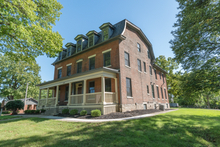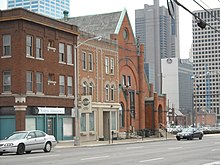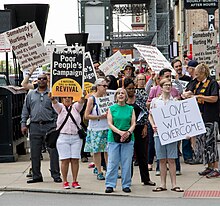
The Lantern is an independent daily newspaper in Columbus, Ohio, by students at Ohio State University. It is one of the largest campus newspapers in the United States, reaching a circulation of 15,000.

Affordable housing is housing which is deemed affordable to those with a household income at or below the median as rated by the national government or a local government by a recognized housing affordability index. Most of the literature on affordable housing refers to mortgages and a number of forms that exist along a continuum – from emergency homeless shelters, to transitional housing, to non-market rental, to formal and informal rental, indigenous housing, and ending with affordable home ownership.

Franklinton is a neighborhood in Columbus, Ohio, just west of its downtown. Settled in 1797, Franklinton is the first American settlement in Franklin County, and was the county seat until 1824. As the city of Columbus grew, the city annexed and incorporated the existing settlement in 1859. Franklinton is bordered by the Scioto River on the north and east, Harmon Avenue on the east, Stimmel Road and Greenlawn Avenue on the south, and Interstate 70 on the west. Its main thoroughfare is West Broad Street, one of the city's two main roads.

The San Francisco Bay Area comprises nine northern California counties and contains four of the ten most expensive counties in the United States. Strong economic growth has created hundreds of thousands of new jobs, but coupled with severe restrictions on building new housing units, it has resulted in an extreme housing shortage which has driven rents to extremely high levels. The Sacramento Bee notes that large cities like San Francisco and Los Angeles both attribute their recent increases in homeless people to the housing shortage, with the result that homelessness in California overall has increased by 15% from 2015 to 2017. In September 2019, the Council of Economic Advisers released a report in which they stated that deregulation of the housing markets would reduce homelessness in some of the most constrained markets by estimates of 54% in San Francisco, 40 percent in Los Angeles, and 38 percent in San Diego, because rents would fall by 55 percent, 41 percent, and 39 percent respectively. In San Francisco, a minimum wage worker would have to work approximately 4.7 full-time jobs to be able to spend less than 30% of their income on renting a two-bedroom apartment.

To Honor the Immigrants is an outdoor 1991–1992 bronze sculpture by Gary Ross, installed at Columbus, Ohio's Battelle Riverfront Park, in the United States.
S.G. Loewendick & Sons, also known as Loewendick Demolition Contractors, is a demolition company based in Grove City, Ohio, a suburb of Columbus. The company is the largest specializing in demolition in Central Ohio. It has torn down most of the landmark buildings in Columbus in recent decades, including Union Station, the Ohio Penitentiary, the Christopher Inn, and the Deshler Hotel.

The Huntington National Bank Building is a bank and office building on Capitol Square in Downtown Columbus, Ohio. Once the headquarters to the Huntington National Bank, it now includes the company's primary lending bank, the Capitol Square Branch. It is part of the Huntington Center complex, which also contains the Huntington Center skyscraper, Huntington Plaza, and DoubleTree Hotel Guest Suites Columbus.

The Ohio National Bank building is a historic structure in Downtown Columbus, Ohio. The Neoclassical building was designed by Richards, McCarty & Bulford, built in 1911, and largely remains as built. It was a long-term location for the Ohio National Bank. It was listed on the National Register of Historic Places in 1980, noted as one of the most significant examples of Greek Doric classical ornamentation in Columbus, with refined details throughout the building.

Budd Dairy Food Hall is a food hall in the Italian Village neighborhood of Columbus, Ohio. The Cameron Mitchell Restaurants-run hall holds ten foodservice locations, three bars, and indoor, patio, and rooftop seating. It is situated in the historic Budd Dairy Company building, a former milk processing and distribution facility. The space was renovated beginning in 2018, and opened in April 2021.
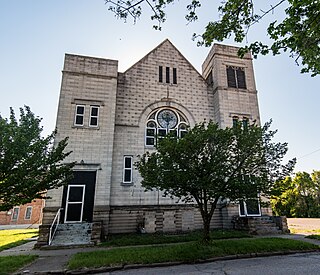
The West Side Spiritualist Church was a historic church building in Franklinton, Columbus, Ohio. The Spiritualist church was built in 1912 for the congregation of Harry Boerstler, who moved to the neighborhood in 1900 to bring hope to its working-class people. The congregation lasted until about 1948, and the building later housed the Boerstler Memorial Spiritualist Temple and the Greater Christ Temple Apostolic Church. After years of vacancy, the church building was approved to be demolished for affordable housing, to accompany an upscale mixed-use development nearby, despite opposition from preservationists.

David Riebel was a German-American architect in Columbus, Ohio. He was the head architect for the Columbus public school district from 1893 to 1922. In 1915, The Ohio Architect, Engineer and Builder considered his firm, David Riebel & Sons, to be the oldest and among the best architects in Columbus.

The CBUS was a free downtown circulator bus in Columbus, Ohio. The service was operated by the Central Ohio Transit Authority. The CBUS service primarily traveled along High Street between the Brewery District and the Short North. The service had uniquely-branded 30-foot buses stopping at round "CBUS" signs. The service operated every 10–15 minutes, seven days per week. The service began operation on May 5, 2014.
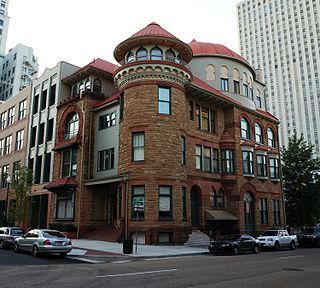
Elah Terrell (1851–1920) was an American architect from Columbus, Ohio. Terrell designed important buildings under the company Elah T. Terrell & Co. in Ohio, notably in Sheffield, Lorain County, and Columbus. Terrell was a member of the Ohio chapter of the American Institute of Architects.

The Ohio Institution for the Deaf and Dumb was a deaf school campus in Downtown Columbus, Ohio. The school, today known as the Ohio School for the Deaf, sat on the present-day Topiary Park grounds in the modern-day Discovery District. The main school building was gutted by a fire on October 2, 1981, though an existing building still stands as Cristo Rey Columbus High School. That remaining building is listed on the National Register of Historic Places and Columbus Register of Historic Properties.

The Columbus Developmental Center (CDC) is a state-supported residential school for people with developmental disabilities, located in the Hilltop neighborhood of Columbus, Ohio. The school, founded in 1857, was the third of these programs developed by a U.S. state, after Massachusetts in 1848 and New York in 1851.

The Neville Mansion is a historic house in the Olde Towne East neighborhood of Columbus, Ohio. Portions of the house may have been built in the early 19th century, though the majority was complete by the mid-1850s. It was built for M.L. Neville, who purchased the property in 1855. Two years later, it became the Ohio Asylum for the Education of Idiotic and Imbecile Youth, which moved out to its current campus in 1868. The mansion then held the Hannah Neil Mission and Home of the Friendless for over a century, from 1868 to 1977. The mission served as an orphanage, homeless shelter, and school for various types of disadvantaged residents throughout its history. After Neil's organization moved out, the mansion was renovated for office use.

The Joseph Henderson House, also known as the A.H. Dierker House, is a historic farmhouse in Columbus, Ohio. The house was built in 1859 by Joseph Henderson for him, his wife, and their ten children. The family lived on-site until the 1930s, when Arthur H. Dierker's family moved in, living there until 1983. The house was added to the Columbus Register of Historic Properties in that year. Since then, the building has been used for offices, and since 2018, a local brewery.

The Renaissance Columbus Downtown Hotel is a Renaissance Hotel in Downtown Columbus, Ohio. The hotel has 22 stories, and was designed by Columbus architects Kellam & Foley in the International style.

The Park Hotel was a hotel in Columbus, Ohio. It was later in its history known successively as the Northern Hotel, the Railway Y.M.C.A., and as the Goodale Hotel. The building stood at the northwest corner of North High Street and Goodale Street.
This is a list of historical and operating fire stations in Columbus, Ohio, part of the Columbus Division of Fire (CFD). Buildings in this list are grouped by station number and are sortable by name, date, and status.

